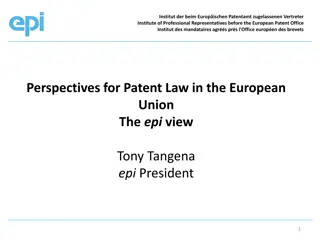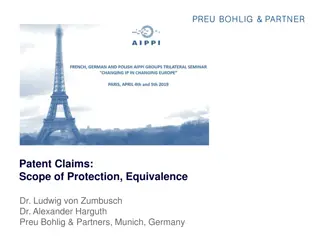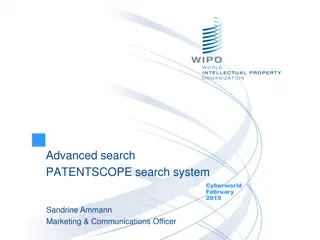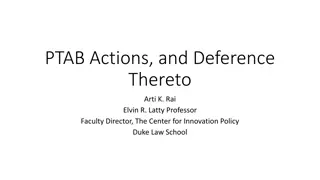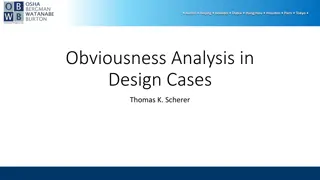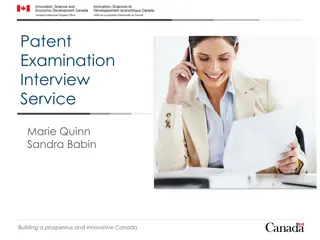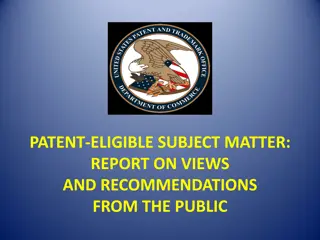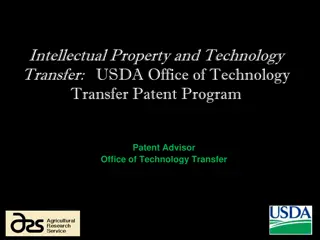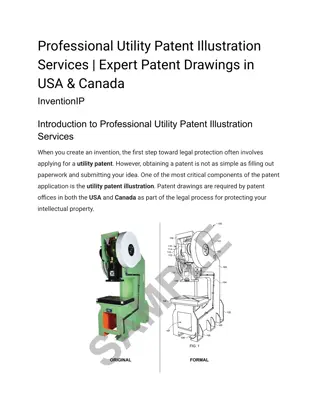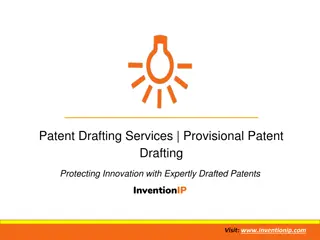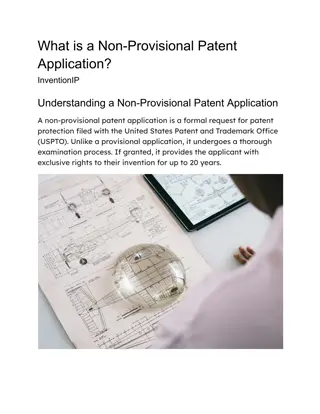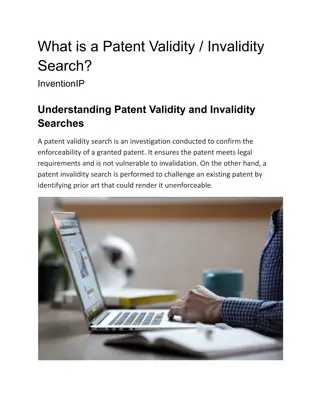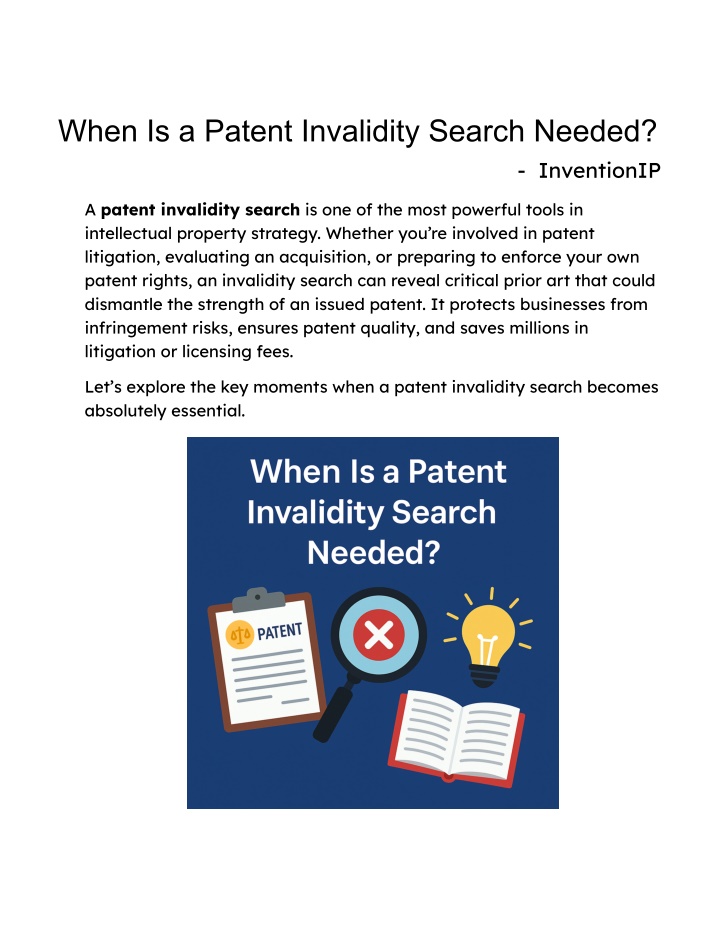
When Is a Patent Invalidity Search Needed? | Key Use Cases | InventionIP
A patent invalidity search is a crucial step in protecting your business from unnecessary legal risks and costly litigation. This comprehensive process involves examining existing prior artu2014such as earlier patents, publications, or public disclo
Uploaded on | 0 Views
Download Presentation

Please find below an Image/Link to download the presentation.
The content on the website is provided AS IS for your information and personal use only. It may not be sold, licensed, or shared on other websites without obtaining consent from the author. If you encounter any issues during the download, it is possible that the publisher has removed the file from their server.
You are allowed to download the files provided on this website for personal or commercial use, subject to the condition that they are used lawfully. All files are the property of their respective owners.
The content on the website is provided AS IS for your information and personal use only. It may not be sold, licensed, or shared on other websites without obtaining consent from the author.
E N D
Presentation Transcript
When Is a Patent Invalidity Search Needed? - InventionIP A patent invalidity search is one of the most powerful tools in intellectual property strategy. Whether you re involved in patent litigation, evaluating an acquisition, or preparing to enforce your own patent rights, an invalidity search can reveal critical prior art that could dismantle the strength of an issued patent. It protects businesses from infringement risks, ensures patent quality, and saves millions in litigation or licensing fees. Let s explore the key moments when a patent invalidity search becomes absolutely essential.
What Is a Patent Invalidity Search? A patent invalidity search is an in-depth examination of prior art existing patents, publications, products, or public disclosures to determine if an already granted patent should be legally invalidated. The objective is to prove that the invention was not new (lacked novelty) or was obvious (lacked an inventive step) at the time the patent application was filed. These searches are often conducted by legal professionals or patent analysts using global patent databases, scientific publications, trade literature, and even products in the public domain. When Is a Patent Invalidity Search Necessary? 1. During Patent Infringement Litigation This is the most common and critical time to conduct a patent invalidity search. If you or your business is accused of patent infringement, challenging the validity of the asserted patent is one of the most effective defenses. Example: In a landmark case, Samsung conducted an invalidity search to challenge Apple s design patents during their smartphone patent war. Samsung s team uncovered earlier designs that closely resembled Apple s patented features, leading to significant reductions in damages. An invalidity search can help uncover prior art that predates the patent or proves that the invention is not unique. Presenting this evidence in court can lead to a dismissal of the case or reduced penalties.
2. Before Filing an Inter Partes Review (IPR) An IPR is a formal procedure at the United States Patent and Trademark Office (USPTO) to review the validity of a patent. To file a successful IPR petition, one must submit compelling prior art evidence. Invalidity searches are the foundation of these filings. Without strong evidence of novelty-destroying prior art, the USPTO may deny your petition. Legal teams often spend weeks gathering ironclad documentation before initiating the review. Case Study: A tech startup targeted by a non-practicing entity (patent troll) filed an IPR after conducting a professional invalidity search. The search revealed an academic paper from three years before the patent filing. The USPTO invalidated several claims of the patent, and the startup avoided a costly legal battle. 3. Prior to Enforcing Your Own Patent Before suing someone for patent infringement, it s critical to evaluate the strength of your own patent. The last thing you want is to bring someone to court and have your patent invalidated during the process. Conducting a self-invalidity search gives insight into any potential weaknesses in your granted claims. If similar prior art exists, it may be better to revise your enforcement strategy or seek settlement instead. 4. In Response to a Cease-and-Desist Letter
If your company receives a cease-and-desist letter based on an allegedly infringed patent, don t panic. Instead, conduct a targeted invalidity search. It may reveal that the patent being enforced is built on shaky ground. Example: A medical device company received a cease-and-desist letter from a larger competitor. Their legal team found prior art in a 10-year-old conference presentation. Using this evidence, they invalidated the competitor s patent and avoided licensing fees. 5. During Licensing Negotiations Licensing negotiations hinge on the perceived value and enforceability of a patent. If you suspect a patent is weak or questionable, conduct an invalidity search. This allows you to negotiate from a stronger position and potentially avoid excessive licensing fees. You may also conduct this search proactively before entering cross-licensing agreements or joint ventures. 6. When Acquiring or Investing in a Patent Portfolio IP due diligence is a crucial part of mergers, acquisitions, or venture capital investments. A patent invalidity search helps assess whether key patents in the portfolio are defensible. Weak patents can reduce the value of the deal and pose significant future liabilities. Case Study: A pharmaceutical firm performed invalidity checks on several patents during the acquisition of a biotech startup. One patent appeared strong
but was later found to be anticipated by an obscure foreign patent. The firm adjusted its valuation and saved millions by avoiding a weak asset. 7. To Combat Competitor Patents Competitors may secure patents that threaten your market freedom. A well-timed invalidity search can challenge and potentially eliminate these patents, clearing the path for your innovation. In fast-moving industries like software, electronics, and pharmaceuticals, proactively identifying and invalidating overly broad patents is a smart strategy. 8. To Reassess Legacy Patents Sometimes, companies sit on a portfolio of old patents. Before investing in renewal fees or using them for licensing, it s worth conducting an invalidity search. If older patents no longer meet patentability standards, letting them expire may be more cost-effective. 9. As a Strategic Defensive Tool Invalidity searches don t always need to be reactive. Many companies integrate them into their IP strategy to monitor competitor filings. When a problematic patent appears, a preemptive invalidity challenge may be filed, creating room for your products. 10. To Avoid Costly Legal Disputes
By identifying and challenging invalid patents early, businesses can prevent lawsuits before they start. A small investment in an invalidity search today can eliminate massive legal bills tomorrow. What Prior Art Sources Are Searched? Invalidity searches pull from a wide array of prior art sources: Issued patents (U.S. and international) Published patent applications Non-patent literature (journals, white papers, textbooks) Public products and systems Conference proceedings Web archives and technical forums The goal is to find any publication or public use that predates the filing of the patent in question.
What Makes an Invalidity Search Effective? Several factors determine the effectiveness of an invalidity search: Deep understanding of patent claims Global coverage of databases Keyword variations and classification codes Technical expertise in the relevant field High-quality documentation of prior art Using experienced professionals or patent search firms increases accuracy and defensibility in legal proceedings. FAQs Q1: Can any patent be invalidated with a search? No. Only those with strong prior art that clearly predates the invention or proves obviousness. Q2: How long does a patent invalidity search take? Typically 2 4 weeks, depending on complexity and the number of claims involved. Q3: How much does it cost? It ranges from $2,000 to $10,000+ depending on depth and jurisdiction.
Q4: Will a patent automatically be revoked after an invalidity search? No. You must present the prior art to the USPTO, courts, or through formal proceedings like IPR. Q5: Can I do it myself? While possible, professional searches are far more thorough and legally defensible. Conclusion A patent invalidity search is not just a legal formality it s a strategic necessity. From fending off lawsuits to evaluating patent strength, its importance cannot be overstated. Companies that invest in invalidity searches are better prepared, more competitive, and less vulnerable to surprise IP battles. If you re facing a potential infringement claim, planning to file an IPR, or just want to know whether a patent can stand the test of time, an invalidity search is your first step. Ready to challenge a patent with confidence? Get expert invalidity analysis from the professionals at InventionIP. Ensure your next move is backed by solid evidence and strategic insight.



